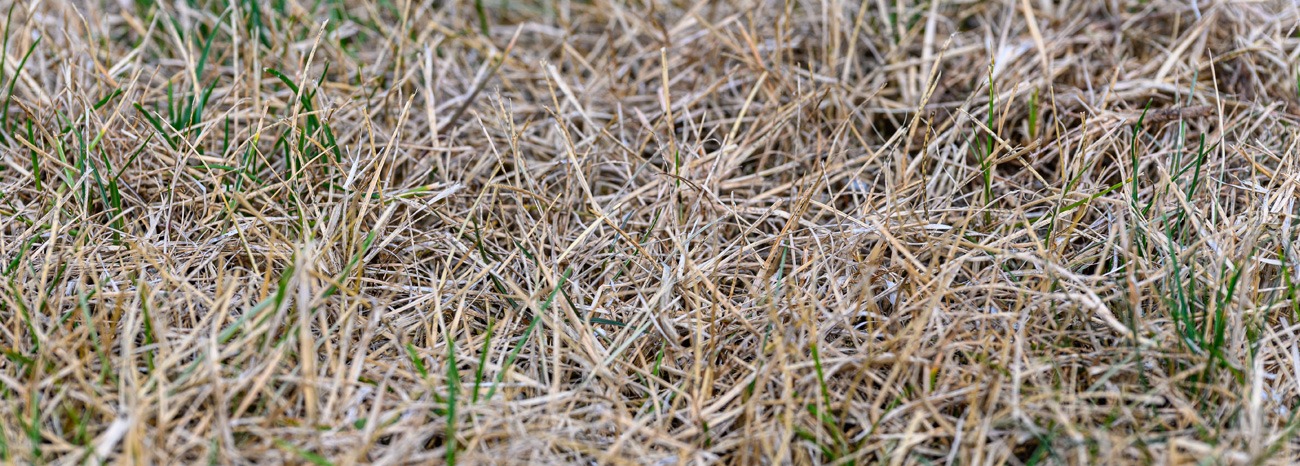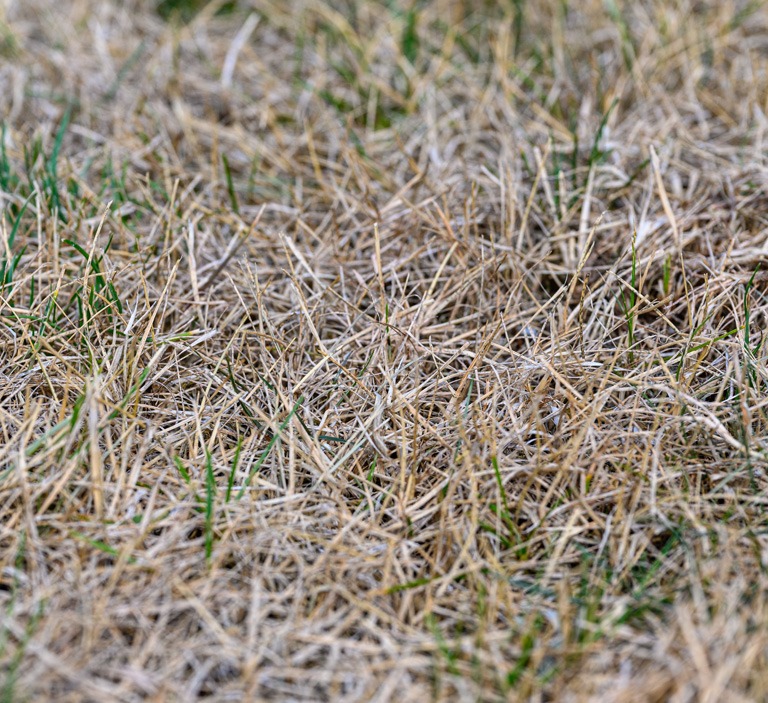One of the most confusing things about lawn care is knowing whether your grass is truly dead—or just taking a break. If your lawn has turned brown and crispy, you might assume the worst. But in many cases, your grass has just gone dormant.
Knowing the difference between dead and dormant grass is the first step in restoring a healthy lawn. Here’s how to spot the signs and what you can do next.
Understanding Dormant Grass
Dormancy is a survival mechanism, a natural state that grass will enter to help it survive the harsh conditions. In periods of extreme summer heat, freezing winter temperatures or during drought conditions grass will stop growing and turn brown, but it’s not actually dead.
How and when your lawn goes dormant depends on the type of grass you have. Here in Pennsylvania, cool-season grasses like fescue and Kentucky bluegrass will often go dormant during hot, dry summers. Warm-season grasses such as zoysia and Bermuda tend to go dormant when temperatures drop in the fall or winter.
How can you tell if your lawn is just dormant and not dead?
- The grass color will shift from green to a light tan or yellow-brown
- The grass may feel dry, but still bends rather than snapping
- You may notice slow or halted growth
These changes will happen across the entire lawn, not in random patches. A dormant lawn isn’t pretty but it’s not an emergency. Think of it as your lawn’s way of taking a power nap. Give your lawn some time and TLC, and it will get back to its gorgeous green self again once the weather improves.
What Dead Grass Looks Like
Here’s how to tell if your grass is truly dead:
- It’s brittle, thin, and grayish in color
- The roots appear dry or non-existent
- Damaged patches are scattered across your lawn
- You can easily pull it up without resistance (this is called the “tug test”)
If you’re still not sure if your grass is dormant or dead, try watering the area consistently for a couple of weeks. Dormant grass will often show signs of life with enough water. Dead grass won’t respond.
Unfortunately, dead grass is not coming back without some help. Grass can die for several reasons:
- Disease
- Pest Infestations
- Poor Soil Quality
- Lack of Nutrients
- Prolonged Neglect
- Severe and Prolonged Drought Conditions
Need help figuring out your grass type and how it responds to local conditions? Our blog on Lawn Grass Varieties in Pennsylvania can help.
Dormant vs Dead: Key Differences
Refer to this side-by-side as you determine the state of your lawn.
Dormant Grass Dead Grass
Color Yellow-brown Gray
Texture Soft, easy to bend Straw-like, breaks easily
Root Condition Roots intact Roots dry and crumbly
Appearance Even coverage Patchy, uneven
Keep in mind, a dormant lawn will eventually recover with time and care. A dead lawn will need more intense renovation.
Caring for Dormant Grass
Here are a few ways to help your dormant grass through the stress:
- Adjust your watering routine. Deep, infrequent watering encourages healthy root growth. Avoid shallow, daily watering.
- Minimize foot traffic. Dormant grass is fragile and can be damaged more easily.
- Raise your mower height. Taller blades help shade the soil and reduce heat stress.
- Don’t over-fertilize. A light feeding might help, but too much can stress already fragile roots. Consult our guide on the best time to fertilize your lawn to learn what’s best for your lawn.
Remember, dormancy is temporary so the best thing you can do is be patient and avoid overcorrecting. Once the weather shifts, your lawn should bounce back.
Want more tips on helping a stressed lawn bounce back? Check out our guide on how to fix a browning lawn.
What to Do If Your Grass Is Dead
If it’s clear your lawn isn’t going to recover, it’s time to make a plan. While it’s not going to come back on its own, the good news is that there are ways to get back to having a lush, green lawn.
Start by clearing away the dead grass. Dethatching or raking can help break up the surface so new seed can take hold. It’s also smart to run a soil test to check pH and nutrient levels before reseeding. If your soil is off balance, the new seed won’t thrive.
When it’s time to reseed or overseed, choose grass varieties suited to Pennsylvania’s climate. For best results, plant during early fall or spring when conditions are ideal. Be sure to water regularly and follow up with a starter fertilizer to give the seed a healthy start. Need help? We walk you through the process in our guide to overseeding.
In some cases, starting from scratch may be the best solution. Our guide to Lawn Renovation can help you get the process going.
A Professional Lawn Plan Makes the Difference
Whether your lawn is in full recovery mode or you’re starting fresh, it helps to have a partner with local expertise. Our Total Green Lawn Care Plan offers year-round treatments tailored to your property. We can help you determine if your grass is dead or dormant, recommend the best course of action and keep your lawn healthy from season to season.
A thick, green lawn doesn’t happen overnight but with the right care, it’s absolutely within reach. Let us help. Call 215.799.2016 or visit our website to get started.
FAQs
How often should I water my lawn during extreme heat or drought conditions?
Water deeply 1–2 times a week, early in the morning. For more, see our article, Lawn Watering Myths Debunked.
Which grass types are most prone to going dormant in our local climate?
In southeastern Pennsylvania, cool-season grasses like fescue and Kentucky bluegrass are more likely to go dormant.
When is the best season to aerate and dethatch my lawn?
Early fall or spring.
How can I prevent lawn diseases and pest infestations?
Your lawn will increase its resilience with regular lawn maintenance, seasonal fertilization and mowing at a proper height.
Are there eco-friendly lawn care practices I can adopt?
Yes, starting with mulching, using natural fertilizers and proper watering. Keep in mind, our Total Green Plan supports these sustainable lawn care practices and is tailored to your yard.


